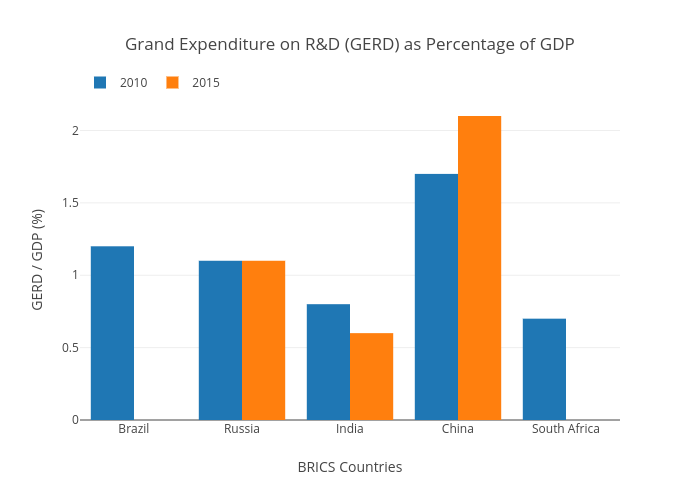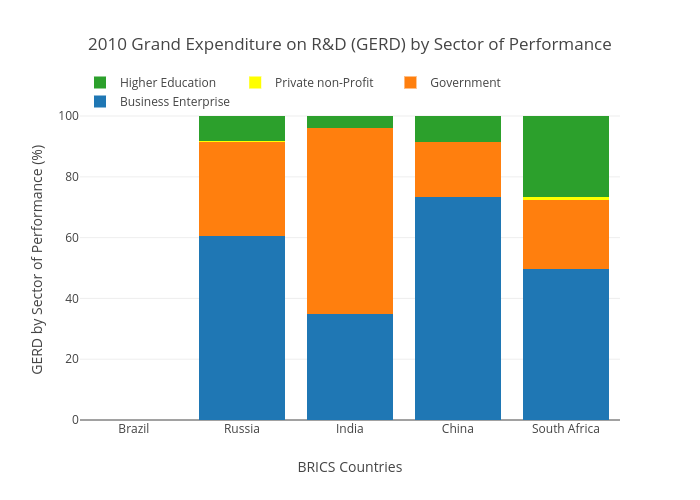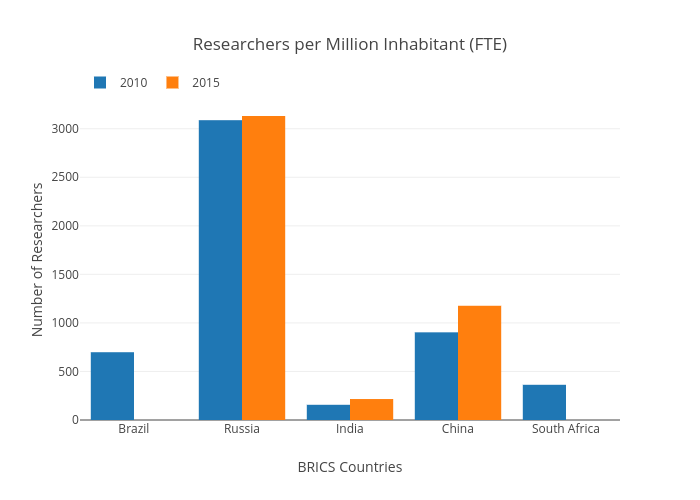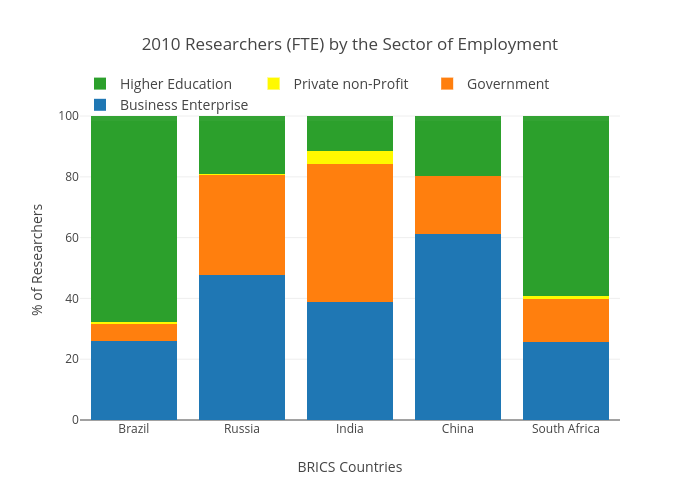Comparative Analysis of R&D Performance between India and rest of the BRICS nations
Research & Development (R&D), which shapes the future of any country is defined as "creative work undertaken on a systematic basis in
order to increase the stock of knowledge, including knowledge of man, culture
and society, and the use of this stock of knowledge to devise new applications." Basic and applied research along with experimental development drives technological innovations. Quality and quantity of innovations are driven by R&D expenditure which decides the amount of manpower and resources employed. R&D performed in a country includes R&D activities from all sources, including government, business, non-profit and higher education institutions; and total expenditure on R&D is defined as Grand Expenditure on R&D, also known as GERD. It is used as R&D indicator worldwide. More details about GERD can be found on OECD manual.
The ratio of GERD and GDP can explain the scope of R&D activities in a country. Indian nationals are well known for their contribution to research in all areas but India is still struggling in retaining best of them in the country. While ground realties many vary from one geographic location to another, I tried to analyze on a national level (in this blog) the R&D expenditure and number of employees working in research in India. It will be unfair to compare India's GERD with developed nations because India is still in a developing phase. So the comparison is made among BRICS nations. GERD data is downloaded from UNESCO website where BRICS data is available only for the year 2010 and the data for the year 2015 is missing for Brazil and South Africa. Original data can be downloaded from here.
Among BRICS countries, India spent only 0.8% of its GDP on GERD, which was little higher than South Africa's 0.7%. India's GERD/GDP ratio came down to 0.6% in 2015. Brazil, Russia and China, all three spent more than 1% of their GDP on R&D where the ratio for China (country with largest population in the world) was highest among BRICS nations and close to OECD average. In contrast, the situation of R&D expenditure in India (which has the second largest population in the world) at a ratio of 0.6% - 0.8% is alarming. This value is also less than half of the world's average ratio.
The ratio of GERD and GDP can explain the scope of R&D activities in a country. Indian nationals are well known for their contribution to research in all areas but India is still struggling in retaining best of them in the country. While ground realties many vary from one geographic location to another, I tried to analyze on a national level (in this blog) the R&D expenditure and number of employees working in research in India. It will be unfair to compare India's GERD with developed nations because India is still in a developing phase. So the comparison is made among BRICS nations. GERD data is downloaded from UNESCO website where BRICS data is available only for the year 2010 and the data for the year 2015 is missing for Brazil and South Africa. Original data can be downloaded from here.
GERD as Percentage of GDP
With technological innovations, R&D activities can support a nation in reaching new heights. It also create new jobs which are necessary for continuous progress of a nation and its citizens. A ratio of GERD vs GDP is used as an indicator to show R&D activities in a country. Some of the countries dedicate close to 4% of their GDP on R&D e.g. in 2010 top 5 countries with largest GERD/GDP ratios were Israel (3.94%), Finland (3.73%), Korea (3.45%), Japan (3.14%) and Denmark (2.93%).Among BRICS countries, India spent only 0.8% of its GDP on GERD, which was little higher than South Africa's 0.7%. India's GERD/GDP ratio came down to 0.6% in 2015. Brazil, Russia and China, all three spent more than 1% of their GDP on R&D where the ratio for China (country with largest population in the world) was highest among BRICS nations and close to OECD average. In contrast, the situation of R&D expenditure in India (which has the second largest population in the world) at a ratio of 0.6% - 0.8% is alarming. This value is also less than half of the world's average ratio.
GERD by Sector of Performance
Out of India's 0.8% GERD/GDP ratio in 2010, a major portion (61.09%) of R&D was performed by government sectors (e.g. government research labs and organizations). Business enterprises performed 34.8% of R&D. Higher Education institutions that play an important role in the country's economy performed only 4.11% of total R&D. On the other hand, South Africa which had minimum ratio in 2010, Higher Education institutions performed maximum among BRICS countries (Brazil data not available during the data download). India's government owned institutions like ISRO and DRDO are known for their contribution in the world and many countries rely on ISRO satellite launch technology. One thing to be noticed here is that Government labs may not be able to generate required volume of jobs as the technological innovations are bound by organization walls. Whereas Higher Education institution expose their lab technologies to world by encouraging entrepreneurship. More entrepreneurs are generated, more jobs are created. This is why it can be observed that South Africa's Higher Education institutions and business enterprise performed 26.78% and 49.66% of R&D respectively. Similar case can also be observed for Russia and China.Number of Researchers per Million Inhabitants
Along with total expenditure on R&D, number of employees working in R&D also affect the research outcomes in a country. According to 2010 data, India had an average 156.64 Full-Time Equivalent (FTE) researchers per one million inhabitants. Compared to other countries, 156.64 researchers per million is an alarming number for India which has the second largest population in the world. This affects the demand-supply ratio which keeps on increasing every year. In 2010, Russia had maximum 3088 and China 902.96 researchers per million inhabitants. This is the reason Russian technology is recognized and many countries depends on it. China , which leads the manufacturing sector and taking over as the world's largest economy is investing more in R&D, increasing its GERD expenditure and employing more and more researchers. South Africa, whose GERD/GDP ratio was less than India in 2010 employed 362.62 researchers per one million inhabitants which was more than twice the number employed in India. On a good note, India was able to increase its researchers to 215.85 in 2015 from 156.64 in 2010. This number might have increased due to initiatives such as INSPIRE fellowships introduced in 2013. However, India's GERD/GDP ratio was down to 0.6% in 2015 which is not possible without reducing R&D expenditure in some areas (both Government and Higher Education institution performed research percentage were down to 52.47% and 3.94% respectively in 2015 compared to 61.09% and 4.11% respectively in 2010).Researchers by Sector of Employment
As indicated by GERD by the sector of performance, number of researchers complement the expenditure. In 2010, India employed 45.59% researchers in government sector and 38.73% in Business Enterprise. Only 11.46% researchers (17.94 researchers per million) worked in Higher Education Institutions in India. Brazil employed a maximum of 67.8% and South Africa employed 59.12% which represents the second largest number of researchers per million in Higher Education institutions.Conclusion
For any country, Higher Education institutions play an important role. Along with increasing overall R&D expenditure, India needs an attentive focus on R&D performed in Higher Education institutions. Research curriculum should be designed in such a way that R&D activities can be encouraged by maintaining education institution independence and allowing public-private research collaboration. This can be achieved by focusing and developing policies such that:- GERD/GDP ratio is increased. Target ratio should be close to 2% which is also average among OECD countries. Once achieved, this can be further increased to a higher ratio in coming years.
- Number of researchers per million inhabitants are increased. This can also result from increased R&D funding which will employ more researchers. Building additional research facilities will also demand for additional researchers.
- Higher Education institutions R&D outcomes are increased. While Higher Education institutions maintain its purpose and don't deliberately works for corporates, private research participation should be encouraged. This will not only financially support institutions, but develop new public-private research programs and gives students an opportunity to engage in industry focused research.








No comments